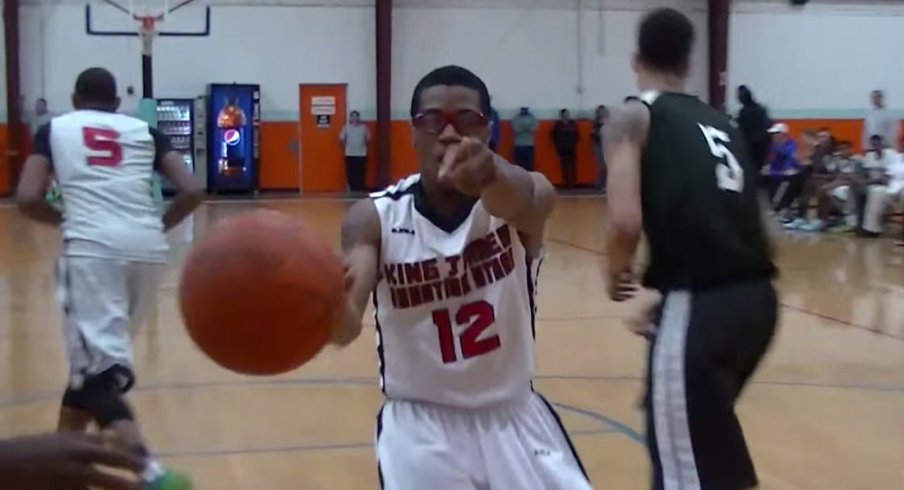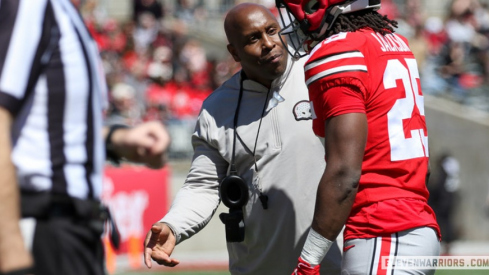If there are two things the Internet is good at, it's arguing and making pretty charts. A Michigan-Michigan State contention has given us a chance to savor both.
Last week, Lansing State Journal sports columnist Graham Couch did something unusual: he published something worth the paper it was printed on. In Couch's story – an examination of Michigan's high school basketball system – he concluded elite prep talent in the state was on the decline, blaming a population drain, AAU teams' popularity and obstructive state high school athletic association rules.
Mgoblog's Seth Fisher criticized the article for perceived pro-Izzo apologetics, acknowledging a potential dropoff but pointing out Michigan's increased regional recruiting. Michigan State writers defended the substance of Couch's claim, providing their own substantial charts.
Minor as the spat may seem, we don't have to care about the Wolverine-Spartan rivalry to learn something from it. We can instead apply some of the same techniques to see if similar trends are going on with Ohio high school basketball.
Ohio basketball's systemic problems aren't as bad as Michigan's (except for population loss in some regions), but it does have its own issues. The state has never been quite as adept at producing basketball talent as it has football talent, and Ohio-born basketball stars don't grow up dreaming of wearing the Scarlet and Gray the same way football players do.
If possible, I'd like to answer a few questions: how many five-star prospects does Ohio produce? How does that total compare to a decade ago? How many of the top stars do the Buckeyes land? Is Ohio basketball in decline?
Although I don't have the same resources and databases Michigan fans have for their own state, I do have is a list of Ohio recruits who were listed in Rivals' Top 150 between 2003 and 2015. It's 52 players in all, from Ivan Harris to Carlton Bragg.
I split the Top 150 stars into three categories: recruits who stayed in Ohio (for example, Yancy Gates playing at Cincinnati), recruits who went to Big Ten schools (like Adreian Payne going to Michigan State) and recruits who took other routes (i.e. Bill Walker committing to Kansas State). Recruits who went to Ohio State are bolded.
| Year | In-State | Big Ten | Other |
|---|---|---|---|
| 2003 | Ivan Harris | -- | LeBron James, Drew Lavender, Brandon Foust |
| 2004 | Jamar Butler, Matt Terwilliger, Josh Duncan | -- | Andrew Brackman |
| 2005 | Derrick Brown | Travis Walton, Korey Spates | -- |
| 2006 | Daequan Cook, David Lighty | Raymar Morgan | James Dews |
| 2007 | Kosta Koufos, Jason Henry, Jon Diebler, Chris Wright, Dante Jackson, Dallas Lauderdale | -- | Bill Walker, Alex Tyus |
| 2008 | Byron Mullens, William Buford, Yancy Gates, Kenny Frease, Terrell Holloway | Delvon Roe, Ryne Smith | Jason Henry |
| 2009 | -- | Garrick Sherman | -- |
| 2010 | Jared Sullinger, Jordan Sibert, Aaron Craft, J.D. Weatherspoon | Adreian Payne | Geron Johnson |
| 2011 | -- | Trey Burke | -- |
| 2012 | -- | Kenny Kaminski | Terry Rozier |
| 2013 | Marc Loving, Kevin Johnson | Mark Donnal | -- |
| 2014 | Jae'Sean Tate | Javon Bess, Vince Edwards, Dakota Mathias | -- |
| 2015 | A.J. Harris | -- | Carlton Bragg, Luke Kennard, Esa Ahmad |
It's hard to see a pattern here; if you squint, you could argue that the late 2000s had the most talent (27 players from 2006-2010), or that the most recent years have seen a dearth of talent (14 players from 2011-2015). But there haven't been any radical population shifts in Ohio, nowhere near what has hindered Michigan schools.
It's also interesting how few players who left the region did well. Only Bill Walker and Drew Lavender had huge success, and Lavender transferred back home to Xavier to achieve it.
When comparing which schools those recruits attended, though, there's a much clearer inference. Of the 52 recruits, 17 went to Ohio State, nine went to another Ohio school, 13 went to a Big Ten school (either Michigan, Michigan State or Purdue), 12 went to a school outside the Big Ten footprint and one was LeBron James. In happy pie chart form:
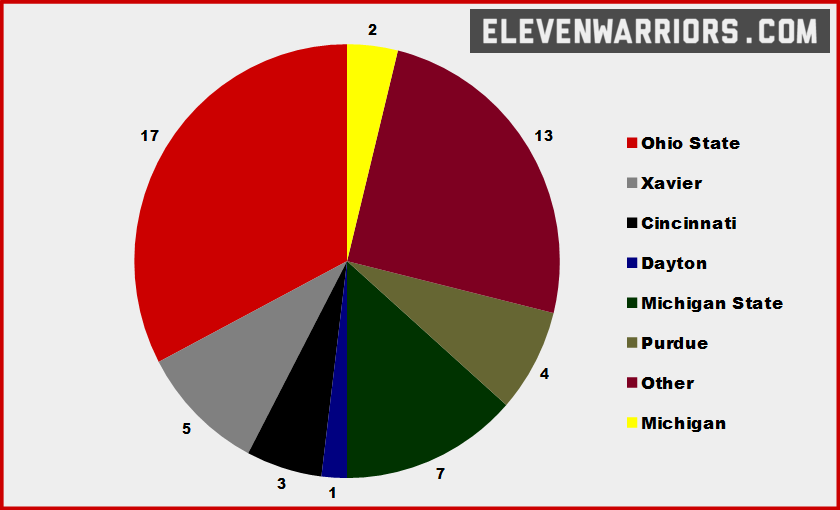
The numbers break down into convenient fractions: about 1/3 of the top Ohioans become Buckeyes, while 1/6 go to other Ohio schools (mostly Xavier). 1/4 go to the Big Ten (Michigan, MSU and Purdue only) while the remaining 1/4 disperse to the rest of the country (primarily Big 12 schools).
Eight of Ohio's Top 150 players went on to the NBA: LeBron James, Daequan Cook, Bill Walker, Kosta Koufos, Chris Wright, Byron Mullens, Jared Sullinger and Trey Burke. Koufos is the second-most experienced, while Sullinger and Burke are poised to overtake him with a couple more good seasons.
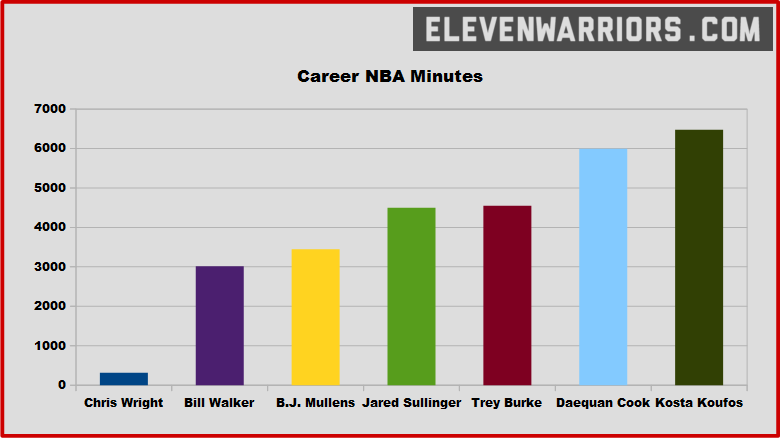
Nevertheless, the collective achievement of these athletes is overshadowed by one man:
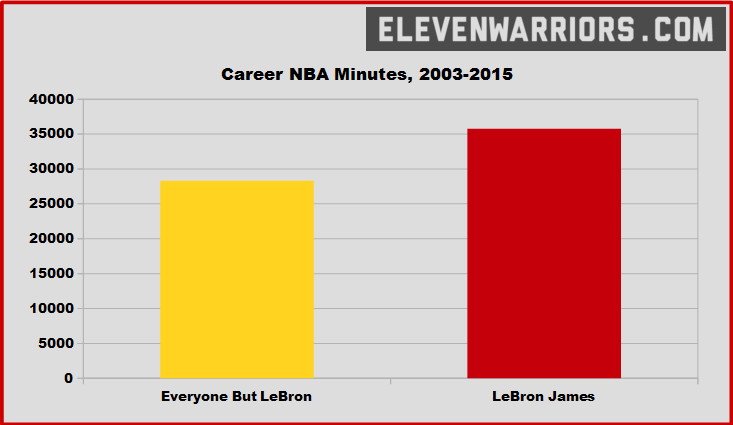
Admittedly, it's not fair to set anyone next to the greatest basketball player of the generation. The temptation was too much to resist.
Totaling up every Ohio-born player in the NBA – this season it's 13 – the Buckeye State is tied for seventh in current NBA players. Since Ohio is seventh in population, it's essentially pulling its own weight.
Is Ohio as talented as in the past? Again, I don't yet have the resources to analyze Ohio's pre-2003 talent. On the other hand, I do have the ability to see how Ohio's recruit rankings are trending. Which is to say, hardly at all.
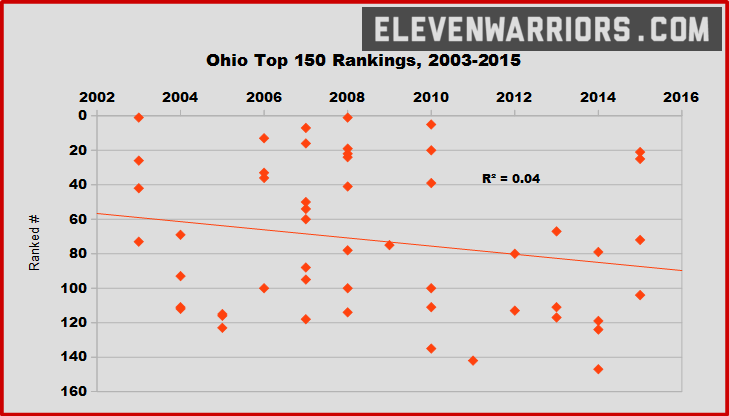
At first glance, the line through the graph may seem to indicate that the average Top 150 Ohio prep star is getting worse over time. But the R-squared value in this chart is important: at .041, it shows practically no correlation.
Unlike with Michigan, which is on a downward tilt, there isn't much backsliding in Ohio. The scatterplot has too much noise to make anything of it, but I doubt it would show a relationship even with more data.
It's not like recruiting rankings are flawless either. Byron Mullens was the top player in his class, while Aaron Craft was 111th two years later. Trey Burke was 142nd in his, and he was the national player of the year two seasons later.
As fun as making these charts is, it is effort in vain. 52 players is too small a sample to make meaningful conclusions about the group, and besides, no player is a finished product in high school. To better represent Ohio, top prep stars need good coaching and stability above all – not charts, no matter how fluffy and colorful they may be.
